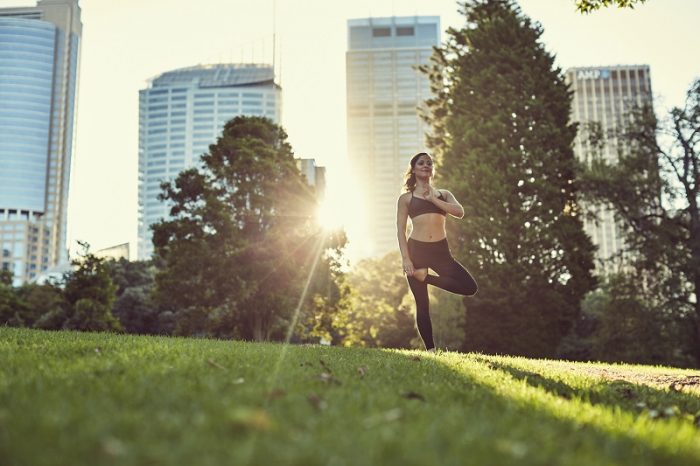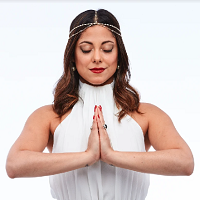Our breath can be our ally or our foe, depending on who’s in control—us or it.
I’ve struggled with chronic anxiety and PTSD since childhood, but it wasn’t until the winter of 2014-2015 that I really spun out of control as I found myself living completely and utterly alone in the middle of the North Carolina mountains, after the life I’d known collapsed around me.
Everything intensified.
I’d wake up with dread every morning, my chest heavy and tight.
I suffered from insomnia every night and couldn’t fall asleep, sometimes until the sun came up.
It felt like I was constantly on the verge of another panic attack, which meant I’d quickly lose control of my breathing as I gasped for air.
I self-medicated and drowned the emotions I didn’t want to feel and the memories I was suppressing in copious amounts of wine each night while mindlessly eating just to find some momentary relief from the dark pressure inside.
I sought refuge in my yoga practice and attended yoga teacher training to find further comfort.
I was a mess and felt lost, until, like a butterfly emerging from her cocoon, I finally shed various old layers of my being. I emerged from the fire of this dark time as a renewed person, but not until I discovered the practice of Raja yoga—the yoga of the mind and emotions.
I taught myself to reclaim control of my life, my body, and my mind, by first reclaiming control of my own breath.
I learned how to breathe calmly and efficiently by studying the ancient yogic wisdom that is known as Patanjali’s Yoga Sutras, the primary text of Raja yoga. The Yoga Sutras are attributed to the sage Patanjali, who, approximately 2,000 years ago, outlined what’s now known as the eight-limbed path.
This path is intended to help us awaken understanding and insight, and cultivate the quality of calm balance regardless of outside circumstance, while also growing inner strength and resolve.
The eight limbs are:
1. Yamas (self-regulating behaviors)
2. Niyamas (personal disciplines)
3. Asana (postures that train the mind and body to become calm and endure distractions)
4. Pranayama (breath/ life force regulation)
5. Pratyahara (withdrawing the senses from the outer world and directing them inward)
6. Dharana (one-pointed focus, concentration, flow state)
7. Dhyana (deep meditation)
8. Samadhi (mind-body integration, union of the self, gratitude, transcendence)
It was through observing the fourth limb, pranayama, that I experienced a visceral shift occurring within. The conscious attention and control of my own inhales and exhales offered me a safe place to direct my anxious and fearful energy.
We can all benefit mentally, emotionally, and physically from a deeper pranayama practice.
Let’s look at a summary of the calming power of our breath according to the Yoga Sutras:
“Accompaniments to the mental distractions include distress, despair, trembling of the body, and disturbed breathing.” ~ Sutra 1.31, Book 1
Our breath and our mental and emotional state form a feedback loop. When we experience mental distress, such as when we’re anxious or sleep deprived, our breathing becomes compromised. When our breathing becomes compromised, our bodies become compromised.
And a weak or sick body or mind makes walking the eight-limbed path more challenging.
“Calm is retained by the controlled exhalation or retention of the breath.” ~ Sutra 1.34, Book 1
Indeed, Patanjali was a sage before his time, for he knew what science has now proven: controlled, deep breathing shifts our nervous system by activating the calming, regenerating, and relaxing response while lowering the stress response.
Controlled, prolonged exhalation, in particular, has been shown to activate our parasympathetic nervous system, the branch of our nervous system responsible for our “rest-and-digest” relaxation response.
“The modifications of the life-breath are either external, internal, or stationary. They are to be regulated by space, time, and number and are either short or long.” ~ Sutra 2.50, Book 2
Here, Patanjali outlines the parameters of a proper pranayama practice: inhalation, retention, and exhalation.
Pranayama variations include: where we focus our attention whilst breathing (on the breath itself, at the base of the spine, or at the heart center), the length of time we hold the breath, the number count we inhale and/or exhale for (inhale for 5, hold for 7, exhale for 10.)
“There is a fourth kind of pranayama that occurs during concentration on an internal or external object.” ~ Sutra 2.51, Book 2
This type of pranayama happens automatically and without conscious effort when we’re really engulfed and focused on something. This is called kevala kumbhaka, which is the easy, unintentional retention that happens when we’re in the flow or in a deeply meditative state.
In the following two sutras, Patanjali discusses the benefits of pranayama:
“As a result, the veil over the light is destroyed.” ~ Sutra 2.52, Book 2
Although it might be hard to believe at first, the simple act of regulating our own breath has the power to create small ripples of change that extend outward, eventually impacting all areas of our life.
This is the biggest benefit of a consistent, regular pranayama practice—the veil of mental darkness and heaviness is destroyed with every conscious breath we take. Eventually, all that remains is our own inner light, and the truth of who we really are is exposed.
“The mind becomes fit for concentration.” ~ Sutra 2.53, Book 2
With the removing of the veil comes a stronger presence of mind and increased mental focus and concentration, which is necessary in order to reach the eighth and final limb: samadhi, or transcendence and union with the self.
The portal through which we can begin to calm our anxious energy in order to transcend to higher states of being is found in our breath.
Now, let’s take a beautiful full breath in by expanding our lower belly. Hold it for two counts and feel the infusion of vital energy filling our lungs.
Let’s exhale slowly and fully as we bring our lower belly in toward our spine.
Repeat. Repeat. Repeat.
Then end with sat nam—I am truth.
~







Read 18 comments and reply